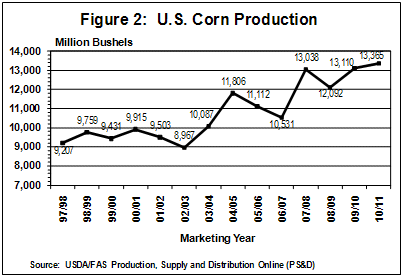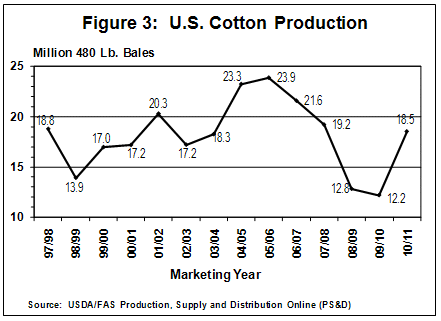Vol. 26, Issue 23, August 12, 2010 – PDF version
Jose G. Peña, Texas AgriLife Extension Economist-Management
As the corn and sorghum harvest in Texas finally gains momentum, grain and cotton markets have improved significantly. (See Figure 1). This improvement appears related to the recent surge in wheat prices. While down slightly since Monday (08.06.10), futures prices for most wheat contracts in the Kansas City Board of Trade (KCBT) have increased close to 50 percent since mid-July’s lows as Russia announced a ban on grain exports. (See Figure 1a). A severe drought, record high temperatures and extended wildfires in Russia and several other wheat producing former Soviet Union countries, is causing a shortage of wheat. Russia imposed a ban on exports to insure domestic supplies.
While the U.S. was the leading exporter of wheat, Russia has become an increasingly important force in the global supply of grains. Russia, together with some wheat producing former Soviet Union countries are considered the world’s largest exporters of wheat. In addition, Russia’s wheat shortages are compounded, in part, as many of the world’s wheat exporting countries have experienced some crop problems. Canada, for example, lost a large portion of their wheat crop to excessive rains. Australia has had major insect predator losses. Some wheat producing regions in the European Union also have experienced losses to drought. Wheat production losses to severe weather in Russia, shortages in other exporting countries, fears of shortages and hoarding by importing countries appear to be driving the surge in wheat prices.
Market spill-over from wheat appears to have influenced the improvement in the U.S. grain and cotton markets. While markets are down earlier this past week, probably also from spill-over weakness from profit taking in the wheat market, futures prices for most grain futures contracts followed a similar market improvement as wheat. December corn futures contracts closed at $4.18/bu. on Monday (08.09.10) after dipping to about $3.44/bu. in late June 2010. Cotton closed higher on Monday despite weakness in the grains, but weakened slightly on Tuesday. December cotton futures prices closed at about 80.9 cents/lb. on Tuesday, down about a penny from Monday, but up about eight cents from recent lows of about 73 cents in mid-July. (See Figures 1b and 1c).
Some analysts contend that the wheat surge might not be sustainable. Fund markets and speculators might have influenced the surge. Profit taking in wheat futures was taking place this past week, tending to weaken markets. But, USDA’s first survey based supply/demand report appeared neutral-slightly-bullish to the market. While some production estimates were increased, use was also increased, leaving carry-over stocks relatively unchanged from last month.
Wheat, Corn, Soybeans and Cotton Production Up
USDA’s first survey-based supply/demand report, released on August 12, 2010, indicated higher wheat, corn, soybeans and cotton production than last month. As of this writing (08.12.10), the report appeared neutral-slightly-bullish to the recent improvement in commodity markets. Futures prices for grain and cotton contracts were showing positive signs on the report release date.
USDA increased the U.S. wheat production forecast, lowered the estimate of domestic feed and residual use from last month’s estimate and increased the estimate of exports, probably as a result of lower exports from Russia, resulting in slightly lower wheat ending stocks.
Corn
USDA’s first survey-based supply/demand report raised the U.S. corn production estimate by 120 million bushels from last month’s estimate to a record 13.365 billion bushels and up 255 million bushels from last season’s crop of 13.11 billion bushels. (See Figure 2). The increased production estimate is primarily based on record average U.S. yields of 165 bu./ac, up 1.5 bu./ac from last month’s estimate and up 0.3 bu./ac from last year’s record. The increased production estimate was partially offset by a lower estimate of carry-in stocks. The estimate of domestic use and exports, however, was increased, dropping the estimate of ending stocks to just slightly below last month’s estimate. Ethanol use remained the same as last month’s estimate, accounting for about 35.2 percent of USDA’s production estimate.
Fundamentals appear to support a relatively stable-to-positive market, especially as influenced by the recent wheat market surge. Keep in mind, however, that USDA’s August estimate of use includes the use of about 4.7 billion bushels of corn for ethanol production. About one-third to 40 percent of this corn will be recycled into livestock feed, which influences the corn market.
USDA raised the season-average farm price for corn by five cents on each end of the range to $3.50 to $4.10 per bushel. Similar price increases are projected for the other feed grains.
Cotton
USDA’s August 12, 2010 first survey-based estimate of cotton for the 2010/11 season indicated higher production and exports compared with last month, resulting in lower ending stocks. Production was raised 234,000 bales to 18.53 million bales (see figure 3), up 330,000 bales from last month’s estimate, as a lower estimate of abandonment, more than offset a reduction in yields. Exports, however, were raised 700,000 bales to 15.0 million based on larger supplies and higher foreign import demand. Ending stocks were reduced by 30,000 bales to a more manageable 3.2 million bales.
USDA raised the projected range of average marketing-year prices by one cent on each end of the range to 61 to 75 cents per pound.
Appreciation is expressed to Dr. Jackie Smith, Extension Economist for his contribution to and review of this article.



